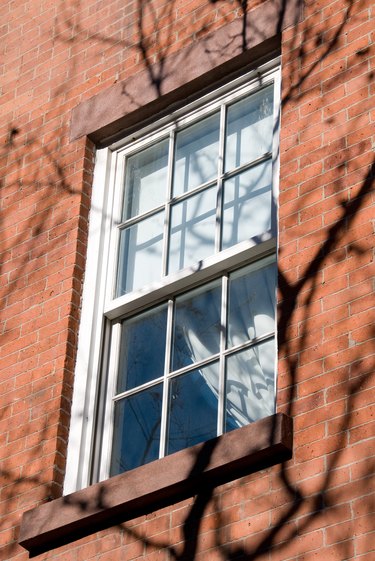
Home remodelers occasionally need to replace glazing beads on aluminum windows, to repair broken glass, convert single-pane to double-pane glazing, or to restore discolored or deteriorating trim. A glazing bead, also called a stop, is the removable window part that holds glass panels in place. Most residential aluminum windows integrate plastic glazing beads into the sash, which is the entire assembly containing the window glazing. Before choosing a plastic glazing bead, remodelers should know their options.
Composition
Video of the Day
Plastics are composed of organic materials, including resins, polymers and additives. They are thermoplastic or thermoset. Thermoplastics soften when heated and harden when cooled but do not change chemically. Thermosets are chemically altered during curing and will not remelt. The most common window component plastics are Polyvinyl Chloride, called PVC or simply vinyl. Vinyl is rigid, semi-rigid or flexible. Manufacturers also offer beads made from other plastics and plastic composites, such as uPVC, ABS, reinforced thermoplastics and fiberglass-reinforced thermosets. Over time, ultraviolet (UV) light, moisture and pollutants degrade the chemical bonds in plastics, affecting color, durability and strength.
Video of the Day
Manufacturing
Plastic glazing beads are typically molded, extruded or pultruded. Molding involves putting liquified plastic into a frame and allowing it to set. Extrusion forces material through a mechanical die with a pressure ram to create a desired shape. Extruded plastic glazing beads are called "profiles." Sometimes, different materials are co-extruded to create duo durometer beads. One part of the bead is soft and rests against the glass, while the other is hard to insert into the sash. Pultrusion is the process of pulling heated materials through a die to create continuous fiber-reinforced polymer or other composite material profiles.
Installation
Plastic glazing beads sit on an L-shaped piece called a "rabbet." They are installed by mechanical screw-on or snap-in/snap-on methods. Screw-on beads fasten with machine screws. Snap-in/snap-on beads attach to anchors or snaps into grooves located on the sash. Remodelers can mount plastic glazing beads into a recessed sash to create a flush edge, called flush glazed, pocket glazed or center glazed. Due to their ease of installation and relative cost, snap-in vinyl glazing beads are the product found most frequently in the residential consumer market.
Features
Higher quality plastic glazing beads are durable, colorfast, rot-resistant, mold-resistant and mildew resistant. They can be straight or bendable. Common colors include beige, black, brown, grey, light brown, light grey, white and mill metal finishes like bronze. They are sold by the foot, in packs or on rolls up to 400-feet long. Manufacturers categorize profiles into groups such as flat, track, box or chamfer beads and sometimes by the number of pieces comprising the bead, such as 3-line or 5-line. Remodelers can order custom colors and profiles for an additional fee.
- Replacement Windows: Aluminum Replacement Windows
- Dictionary.com: Plastic
- Traco: Window Industry Language
- Encyclopedia: Thermoset
- Keller Products, Inc: Manufacturer of Extruded Plastic Profiles
- Plastic Extrusion Masters: Material Specification
- Gorell Windows and Doors: Glossary of Window and Door Terms
- Lauren Manufacturing: Dual Durometers
- Strongwell Corporation: Pultrusion